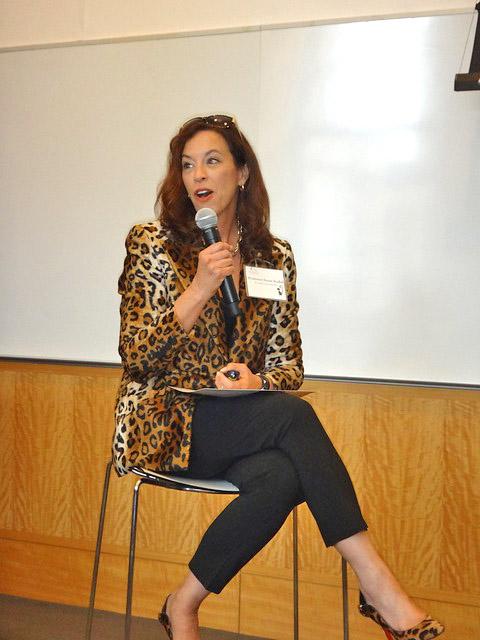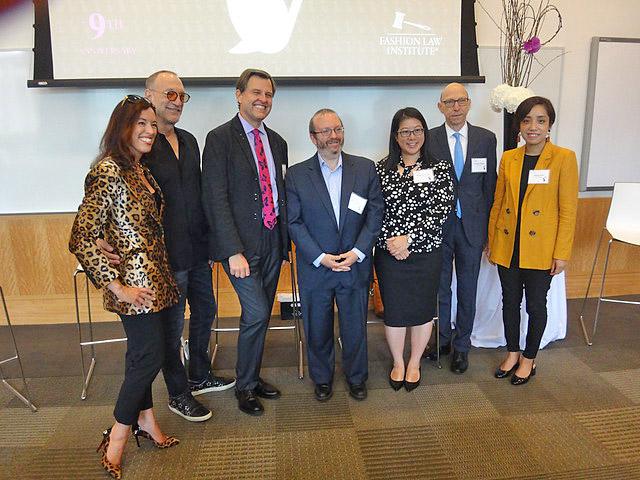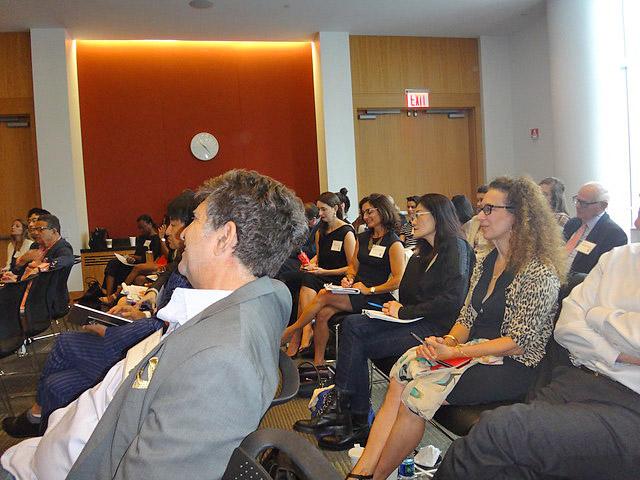
Photos Laurel Marcus
We’ve always had retail,” said Professor Susan Scafidi, founder and director of Fordham’s Fashion Law Institute at Friday’s breakfast seminar. “Fashion is pointless unless you can get it to the consumer.” Whether you’ve Marie Kondo’d all of last season’s former faves or want to update your wardrobe with a few key pieces chances are you’re contributing to “Fashion’s 9 Lives: Retail Survival in Turbulent Times.”
In celebration of the Institute’s 9th anniversary, the ever-creative Prof Scafidi (who always themes her seminars) presented the year of the cat complete with a curling nine tail. I had a strong inkling that her OOTD would include a spotted feline garment or two—BINGO– a gorgeous fur-like leopard blazer and matching (Louboutin) pumps.

Danica Chin, Charles Miller, Anna Fan
Panelists included Gary Wassner, CEO, Hilldun; Jeff Trexler, Co-Founder, Moda Legal and Fashion Law Institute’s Associate Director; Jon Gold, V.P., Supply Chain and Customs Policy, National Retail Federation; Charles Miller, VP, Government & Public Affairs, Macy’s; Danica Chin, Counsel, Tiffany & Co.; and Anna Fan, Director, New York at Hong Kong Trade Development.
“So who’s going bankrupt next?” asked Professor Scafidi as the long-rumored Madison Avenue staple known as Barneys (more on that topic to come) was revealed to be in distress once again (they previously filed for bankruptcy in 1996). Could it be Forever 21? What’s it going to do to malls and real estate? What of the U.S./ China trade war as the 15% tariffs just kicked in this past week. This is significant as approximately 40% of clothing, and 70% of shoes come from China.
We got to hear about Barney’s difficulties right from the horse’s mouth — Wassner is on the Barneys creditors committee –- he decides who gets paid and how much. What gives with Barneys? “Everyone said that brick and mortar is dead, everything is direct to consumer,” he explained. “Free shipping both ways means you’ll never have the discomfort of facing a human being to return things. This resulted in dilution and deterioration. Brands are realizing that they can’t ignore brick and mortar.

There’s marketing just by seeing and walking through a store –margins are narrow if you have to spend on marketing. Barneys should have diversified, not opened more stores. They didn’t make use of the great I.P. (Intellectual Property) of the brand and ignored other channels of distribution in favor of too much retail space.”
Wassner used Harrods main floor of food as an example. “If you have an entertaining environment, you can draw people in for other reasons, and they’ll stay (longer) resulting in a higher rate of conversion (sales). Less traffic, less conversion.” What now for Barneys? “We’re working very diligently on finding a buyer,” he added. Unfortunately, Madison Avenue is much weaker than it was – gone are the Chinese, Russian, or Brazilian shopping tourists.
A whole conversation about administrative insolvency ensued – what I gleaned is that Wassner in his role at Hilldun advises fledgling brands on whom to sell to and who not to. He guarantees their payment for goods, so if a store goes bankrupt, he is on the hook to pay the brand – something he (wisely) will not do for Barneys at this time. It’s a Catch-22 situation because he wants Barneys to recover financially but is unable to allow his clients to provide them with current merchandise.
Jeff Trexler called bankruptcy proceedings “Thunderdome meets Wonderland.” “There’s a sense that the rules don’t apply. Everything is up for grabs while nothing is as it seems. Words mean something different than you think in this situation.” He explained that a vendor (particularly a jewelry brand that lends stores items on consignment) could lose their merchandise for good as it will be sold off as part of the bankruptcy, never mind that the store doesn’t technically own it. Consignors must have an airtight UCC or Universal Commercial Code agreement in place, and even then they may need a good lawyer. He pointed out the fact that bankruptcy law is a good one for lawyers since they are guaranteed payment.
“I feel like I’m in Thunderdome every day in D.C.,” said Jon Gold who had taken a pre-dawn plane, train and automobile to be at the seminar at 9 am along with his slide show. Did you know that retail is the largest private sector employer in the nation contributing $2.6 trillion to the annual GDP? “We have more I.T. specialists than Silicon Valley,” he continued. “I’m a trade geek – I believe in free trade – not like now,” he said, showing a slide of President Trump in a superhero suit labeled “Tariff Man.”
He railed against losing NAFTA, supplying a light moment in which he showed the “tariffs are bad” clip from Ferris Bueller’s Day Off. “The farmers are getting killed,” he said while displaying an ad run by the NRF called “Tariffs hit the homeland.” “It’s U.S. bureaus and U.S. consumers who pay the debt, not the Chinese. This is having an impact on the whole world’s economy.”
Charles Miller of Macy’s was admittedly a lot less strident. “We try not to become too political. Macy’s wants to sell to everyone regardless of political inclination. We have the NRF assert for us. We rely on them,” he said likening Macy’s role to the guy on Mutual of Omaha’s Wild Kingdom who waits in the jeep while Jon wrestles the alligators. Miller also took a more optimistic view that the tariffs will be temporary. Meanwhile, they are trying to diversify their product sources out of China, shift resources, and tailor their supply chains accordingly.
Danica Chin remarked that Tiffany’s does all their production in the U.S. or Europe. They are busy trying to get their product into Hong Kong despite the current situation of protests. “We want a slice of the pie there – we’re trying to break into that market. Chinese consumers are used to traveling abroad to shop. It’s been much cheaper for them for many years.”
A little history lesson – in 1840, China ceded Hong Kong to Britain, but it was returned to Chinese sovereignty in 1997 with the understanding that the status quo would be maintained. “Hong Kong is one of the financial capitals of the world. They’re very fashion-forward and love shopping for high-end brands.” She admitted that stores are currently taking a hit due to the protests often subject to frequent closures. “Disruption causes a lot of problems –however the new Tiffany flagship is opening next month with the first Blue Box Café outside of the U.S.”
Anna Fan is a Big Apple newbie who moved here last May — she is responsible for promoting Hong Kong trade. “The U.S. respects Hong Kong; they don’t steal I.P.,” she said. The other day she noticed all her Facebook friends with cocktails celebrating the government’s withdrawing the extradition bill. “It involves a lot of young people – they’re very idealistic but not so realistic. They don’t know the art of compromise.” She believes the tariffs could be the new normal but adds that it’s hard to switch all the production to Southeast Asian countries since they’re so much smaller than China and unable to absorb all of it.
What about re-shoring production in the U.S.? Wassner said that he just acquired a knitwear manufacturing space in St. Louis for a client with very high tech machinery for $58 a square foot. “It changed the way we think about manufacturing here.”
“With any disruption, there will be winners and losers,” added Miller. Chin agreed that the chaos has created an opportunity for leasing. “We usually have no leverage, but now we can negotiate a lot more,” she said. Fan agreed that disruption creates innovation, particularly with fabrics becoming newer and lower in cost. “There’s customization in sneakers – they’re focused less on craftsmanship and more on cross-branding,” she said.
“Barney’s bankruptcy is not the end but the beginning of the next phase,” said Trexler. Even Gold agreed, “Retail isn’t dying; it’s evolving. We need to be innovative to reach the customer — push retail further. How can we do it better?”
